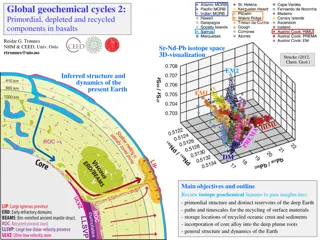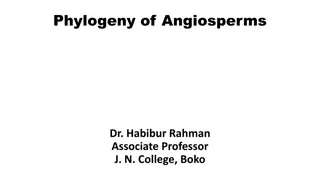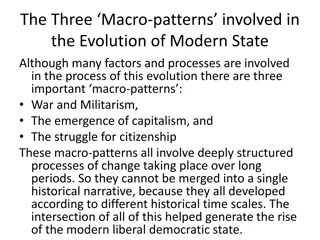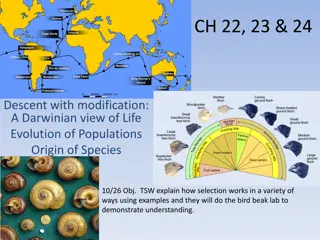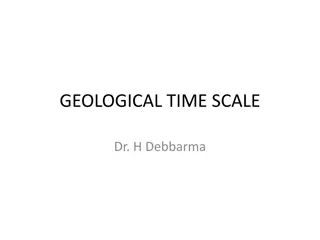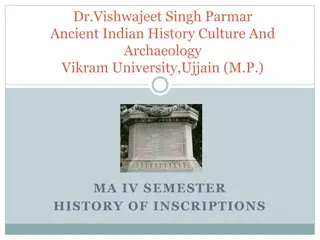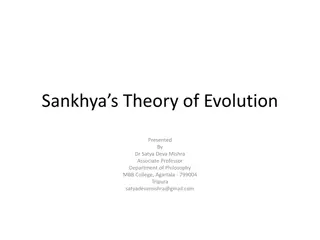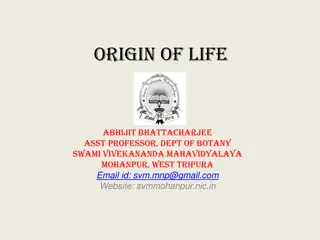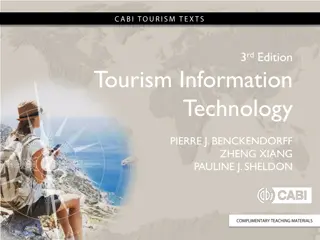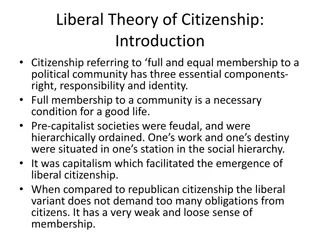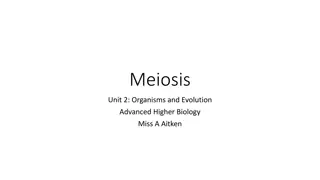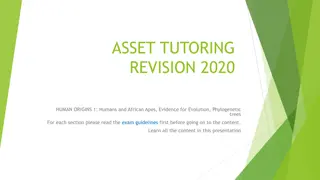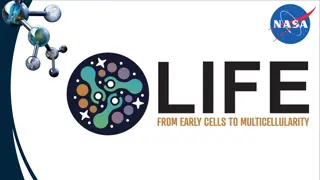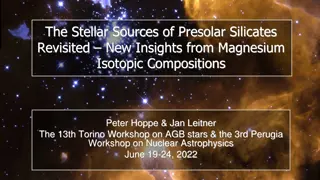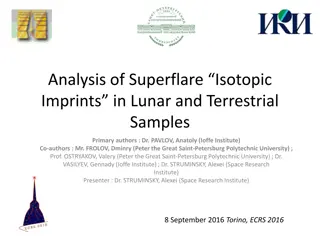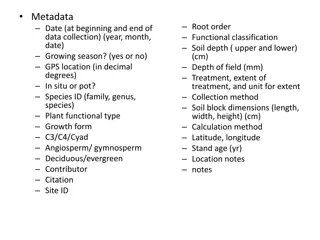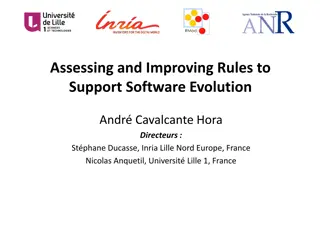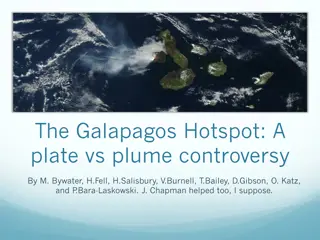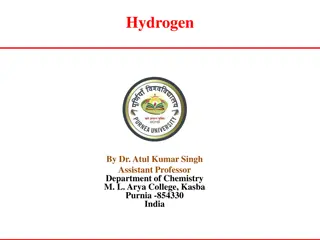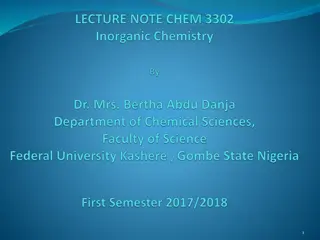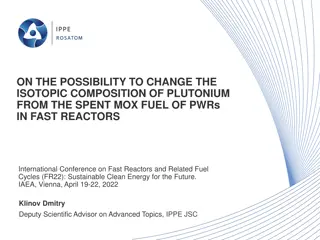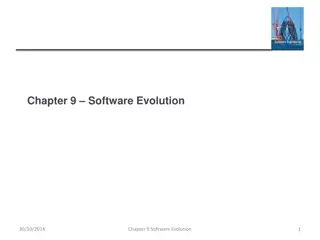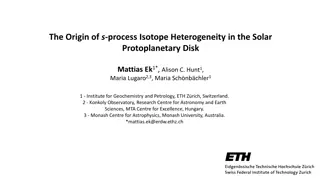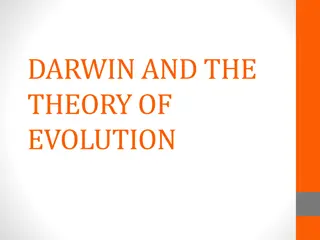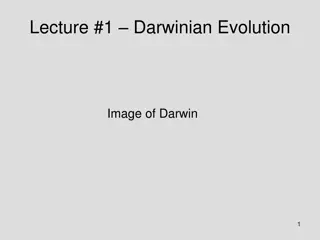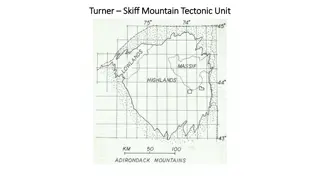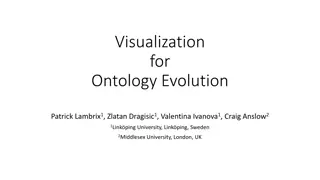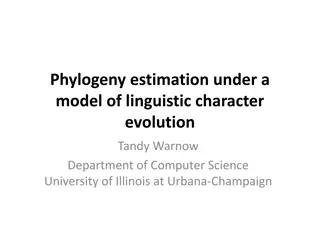Evolution and Plant Systematics Lecture Overview
This lecture outline delves into the concepts of evolution, unity, and diversity of organisms on Earth, covering topics such as fossils, Lamarck and Darwin's theories, adaptation, natural selection, artificial selection, Carolus Linnaeus' systematics, plant evolution, and the demonstration of evolut
5 views • 26 slides
Critique of Unilinear Cultural Evolution Models
The drawbacks of unilinear cultural evolution models are explored, focusing on the assumption that all cultures follow a single linear path of development. Issues such as the emphasis on material culture, overlooking of other cultural aspects, and the ethnocentric perspective towards Western culture
16 views • 17 slides
Insights into Earth's Geochemical Cycles and Isotopic Evolution
Explore the primordial, depleted, and recycled components in basalts to understand deep Earth reservoirs, recycling paths, and core-mantle dynamics using isotope geochemistry. Learn about radioactive decay systems, mantle array evolution, and U-Th-Pb systematics in planetary differentiation.
6 views • 30 slides
Understanding Phylogeny and Evolution in Angiosperms
Phylogeny is the study of evolutionary relationships among organisms, depicted in phylogenetic trees based on shared characteristics. This overview delves into terms like homology, analogy, monophyly, and co-evolution in angiosperms with an emphasis on taxonomy, systematics, and the evolutionary his
1 views • 25 slides
Evolution of Modern State: Three Macro-Patterns Explored
The evolution of the modern state is influenced by three key macro-patterns: War and Militarism, Emergence of Capitalism, and Struggle for Citizenship. These patterns involve deep processes of change over long periods, contributing to the development of modern liberal democratic states. War and Mili
0 views • 13 slides
Evolutionary Concepts and Natural Selection Explained
Descent with modification and natural selection play key roles in the process of evolution, as outlined by Darwinian principles. Through examples and historical context, the mechanisms of adaptation and survival of species are elucidated. The concept of variability within populations and the impact
0 views • 15 slides
Understanding the Geological Time Scale and Earth's Evolution
Studying the geological time scale is crucial for comprehending Earth's history, evolution of life, and significant events that shaped our planet. Evidences like field observations, fossil records, and radioactive dating contribute to constructing this vast timeline. Major occurrences such as mass e
1 views • 46 slides
Evolution of Inscriptions in Ancient Indian History
The evolution of inscriptions in ancient India reflects a shift from Prakrit to Sanskrit languages over the centuries, marking changes in content, purpose, and classification. Beginning with Brahmi inscriptions, the transition to Sanskrit gradually replaced Prakrit as the language of choice in North
0 views • 12 slides
Sankhya's Theory of Evolution Explained by Dr. Satya Deva Mishra
Explore the Sankhya philosophy's theory of evolution as presented by Dr. Satya Deva Mishra, covering concepts such as Prakrti, Purusa, theory of causation, evolutes of Prakrti, and the purpose of evolution towards liberation and self-realization.
2 views • 8 slides
Evolution and Impact of Wi-Fi Technology Trends
Discussion on the next generation Wi-Fi technology evolution, target objectives, and requirements aligning with market needs. The presentation covers the evolution of Wi-Fi technology based on requirements from 1997 to 2023, emphasizing the increasing importance of Wi-Fi due to global trends during
1 views • 14 slides
The Mysteries of Life: Origins, Evolution, and Plant Cells
The origins of life on Earth, spanning billions of years, continue to intrigue scientists. From the emergence of the Earth to the evolution of plant and animal life forms, the journey of life is a profound tale of adaptation and survival. Explore the fascinating hypothetical views on the origin of l
2 views • 14 slides
Evolution of Internet Technology in Tourism: A Comprehensive Study
Exploring the impact of the Internet on tourism, this study delves into topics such as historical evolution, Internet usage by travelers and organizations, search engine optimization, and web development for successful tourism sites. Key concepts like ISPs, servers, domains, and eCommerce are discus
0 views • 23 slides
Evolution of Liberal Citizenship Theory
The liberal theory of citizenship emphasizes the essential components of right, responsibility, and identity within a political community. It contrasts with pre-capitalist societies by offering a weak sense of membership and reduced citizen obligations. The addition of social rights has brought an e
0 views • 15 slides
Understanding Meiosis: Key Concepts in Biological Evolution
Meiosis is a crucial process in organisms, involving the formation of haploid gametes with unique allele combinations. This process ensures genetic diversity through crossing over and independent assortment, leading to variations essential for evolution. The significance of homologous chromosomes, d
1 views • 22 slides
Understanding Human Evolution: From Ancestral Lineage to Modern Hominids
Human evolution is a fascinating journey of change and development, where humans emerged as a distinct species. The theory of evolution highlights our common ancestry with other organisms, including chimpanzees. Evidence from fossils, genetics, and culture supports the idea of a shared ancestor amon
1 views • 23 slides
Exploring Human Origins: Evolution and Phylogenetic Trees
Delve into the fascinating realm of human origins through an examination of humans and African apes, evidence for evolution, and the construction of phylogenetic trees. Understand the relationships between species, common ancestors, and key evolutionary developments that have shaped the course of hu
4 views • 18 slides
Exploring Life-Planet Co-Evolution: Goals and Initiatives
A community dedicated to understanding the co-evolution of life and planet through rock records, biodiversity, genome databases, and modeling. Goals include unraveling major biological innovations and predicting life evolution on other worlds. Initiatives involve collaboration, outreach events, semi
1 views • 14 slides
Evolution of Compact Star-Forming Galaxies and Quiescent Galaxies
The evolution of galaxies from compact star-forming to quiescent states involves processes such as secular evolution, gas inflows, and star formation quenching. By studying the structural relations and star formation in these galaxies, insights are gained into their transition towards quiescence. Th
0 views • 12 slides
Insights on Presolar Silicates and Magnesium Isotopes
Primitive meteorites contain presolar grains with unique isotopic compositions, paving the way for the study of stardust from stars to laboratories. Ion imaging techniques reveal the abundant presence of presolar silicates, showcasing advancements in in situ studies facilitated by cutting-edge techn
0 views • 17 slides
The Scopes Monkey Trial: Clash of Cultures and Evolution Debate
Following World War I, the Scopes Monkey Trial in Tennessee marked a pivotal clash between urban and rural cultures over the teaching of evolution. The trial, prosecuted by William Jennings Bryan and defended by Clarence Darrow, resulted in teacher John Scopes being found guilty of violating the ant
0 views • 9 slides
Analysis of Superflare Isotopic Imprints in Lunar and Terrestrial Samples
Researchers investigate isotopic imprints in lunar and terrestrial samples to understand extreme solar events and their impact on atmospheric radiocarbon concentrations. Using 10Be and 36Cl data, they analyze the solar proton spectra and energy fluxes associated with these events, shedding light on
0 views • 13 slides
Root Morphology and Chemistry Data Collection in Plant Study
This dataset includes detailed metadata on root characteristics, such as diameter, branching intensity, mycorrhizae type, along with root chemistry data like nutrient concentrations and stable isotopic values. Soil dynamics, including temperature and texture, and climate information are also documen
0 views • 4 slides
Non-Isotopic Labeling for Molecular Detection
The use of non-radioactive probes in molecular detection involves synthetic DNA or RNA molecules with specific target sequences and reporter groups detectable via fluorescence spectroscopy. Direct and indirect labeling methods utilize fluorescent dyes or enzymes conjugated to modified nucleotides, a
0 views • 20 slides
Rules and Practices for Software Evolution Support
This content focuses on the importance of rules and practices to support software evolution, addressing challenges, benefits, and impact on ecosystems. It emphasizes the need for system-specific rules, automatic extraction of conventions, and client support. The evolution of software is highlighted
0 views • 65 slides
Debunking the Galapagos Hotspot: Plate vs. Plume Controversy
Situated in the Pacific Ocean, the Galapagos Islands have sparked a debate on whether they were formed by mantle plumes or the spreading ridge. Evidence refuting the plume theory includes variations in isotopic compositions, non-progressive volcanic activity, unique morphology, seismic findings, and
0 views • 9 slides
Overview of Hydrogen: Properties, Isotopes, and Characteristics
Hydrogen, a colorless gas with atomic number 1 and mass 1.008 amu, exhibits electropositive and electronegative characteristics due to its electron configuration. It has three isotopes - protium, deuterium, and tritium - with varying reaction rates. Protium is the most abundant isotope. This element
0 views • 8 slides
Insights into Hydrogen: Properties, Reactions, and Applications
Discover the key properties, preparation methods, and isotopic composition of hydrogen. From its role as the most abundant element in the universe to its use as a powerful reducing agent and industrial reagent, explore the diverse characteristics and applications of this versatile element. Learn abo
0 views • 87 slides
Understanding Isotopes in Biogeochemistry
Isotopes are atoms with the same number of protons but different numbers of neutrons. This presentation explores the significance of stable isotopes, types of isotopes, expressing isotopic abundances, isotope effects, and applications to geochemical studies. Learn about common light element stable i
0 views • 14 slides
Innovations in Reprocessing Spent MOX Fuel for Sustainable Nuclear Energy
Discussion at the FR22 Conference focuses on the potential for fast reactors to modify the isotopic composition of plutonium from spent MOX fuel of PWRs. By utilizing fast reactors like BN-800, countries can alter the fissile isotopes in plutonium, enabling its reuse in thermal reactors and effectiv
0 views • 8 slides
Software Evolution: Managing Change and Evolution in Organizational Systems
Software evolution is an essential process for organizations to maintain the value of their critical business assets. It involves adapting to new requirements, addressing errors, and enhancing performance. The majority of software budgets in large companies are dedicated to evolving existing systems
0 views • 61 slides
Understanding Isotope Heterogeneity in Solar Protoplanetary Disk
Explore the origin of s-process isotope heterogeneity in the solar protoplanetary disk, delving into cosmochemistry, isotopic variations in meteorites, and the significance of internal normalization. Discover the correlation between Pd isotope compositions in iron meteorites and the solar system s-p
0 views • 17 slides
Darwin and the Theory of Evolution: A Comprehensive Overview
Darwin's Theory of Evolution encompasses the concepts of organisms changing over time and life evolving through natural selection. Influenced by scientists such as James Hutton, Jean Baptiste Lamarck, and Alfred Russel Wallace, Darwin's theory culminates in the idea of evolution by natural selection
0 views • 9 slides
Understanding Evolution: Key Concepts and Perspectives
Explore the concepts of Darwinian evolution, evidence for evolution, Darwin's theory, and the Modern Synthesis. Delve into the spiritual versus intellectual perspectives, the diversity of religious affiliations globally, and the compatibility of faith and science in understanding the natural world a
0 views • 91 slides
The Complicated Formation of Earth's Water: A Detailed Overview
Jun Wu and colleagues at Arizona State University have developed a comprehensive model to explain the origin of Earth's water through stages such as planetary accretion, core formation, and interactions with the solar nebula. By tracing the isotopic composition of hydrogen, they explore how water so
0 views • 7 slides
Exploration of Turner Turner Skiff Mountain Tectonic Unit
Detailed documentation of Turner Turner Skiff Mountain Tectonic Unit, including images, fieldwork descriptions, rock types, and isotopic analyses. The unit showcases layered granite gneisses, magnetite ore bodies, retrograde metamorphism, metagabbro sills, and leucosome formations near Arnold Pond.
0 views • 25 slides
Unveiling the Cosmic Evolution: A Journey Through Galaxies, Stars, and Empty Space
Delve into the intricate story of the universe's evolution from its hot dense origins to the vast cosmic web of stars and galaxies. Explore questions on stellar birth rates, interstellar medium influences, and the role of dark energy. Follow the journey of three students working on the Cosmic Evolut
0 views • 30 slides
Understanding Evolution: Key Concepts and Perspectives
Explore the key concepts of Darwinian evolution, including evidence for evolution, Darwin's theory, and the Modern Synthesis. Reflect on the relationship between spiritual and intellectual perspectives, emphasizing that different ways of thinking can complement each other. Discover the diversity in
0 views • 91 slides
Visualizing Ontology Evolution for Improved Knowledge Management
Ontologies are dynamic entities that evolve over time, impacting semantically-enabled applications and knowledge acquisition. This work focuses on identifying desired functionalities for ontology evolution systems, highlighting the steps involved in ontology evolution, and emphasizing the importance
0 views • 16 slides
Evolution of Indo-European Languages through Phylogeny Estimation
Explore the evolution of Indo-European languages through phylogeny estimation under a model of linguistic character evolution. Follow the Computational Historical Linguistics Project's collaboration that began in 1994, leading to the development of methods and studies on homoplasy-free evolution and
0 views • 61 slides
NuMI/LBNF Radiation Protection Overview
This overview discusses key aspects of radiation protection at NuMI/LBNF, including air release radiation protection, isotopes of concern, monitoring processes, dose calculation models, and permit limits. The content covers factors like transport, Tritium production, isotopic decay, and public expos
0 views • 19 slides


